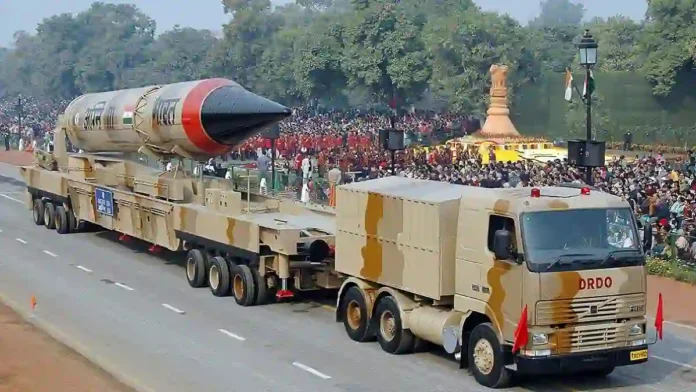India has consolidated and expanded its nuclear advantage over Pakistan, according to the Stockholm International Peace Research Institute (SIPRI) Yearbook 2025. As of January 2025, India’s nuclear arsenal is estimated at 180 warheads, up from 172 in 2024, while Pakistan’s stockpile remains at 170 warheads, unchanged from the previous year. This numerical lead is complemented by significant strides in India’s nuclear delivery technology and posture.
India’s modernisation drive is most evident in its development and deployment of advanced, cannisterised missile systems. These next-generation missiles, such as the Agni Prime (Agni-P) and the Multiple Independently Targetable Re-entry Vehicle (MIRV)-capable Agni-5, represent a leap in operational readiness and survivability.
Read- Tejas Mark-1A Fighter Jet: HAL Accelerates TEJAS MK-1A Production
Read- India Conducting A Feasibility Study For Constructing 113 Km-Long Canal For Redirecting Surplus Flow
Canisterisation allows warheads to be pre-mounted and safely transported, enabling India to potentially keep nuclear warheads mated to missiles even during peacetime. This not only reduces response time but also enhances the credibility of India’s deterrent.
The Agni-P, a new-generation missile with a range of 1,000–2,000 km, and the MIRV-capable Agni-5, with a range exceeding 5,000 km, are at the forefront of this technological upgrade.
The MIRV technology, in particular, enables a single missile to carry and deliver multiple warheads to different targets, greatly increasing the effectiveness and complexity of India’s strategic arsenal. These advancements move India closer to a credible second-strike capability, especially with the integration of nuclear submarines and diversified delivery platforms.
While Pakistan continues to develop new delivery systems and accumulate fissile material, SIPRI notes that its pace of modernisation lags behind India’s. Pakistan’s nuclear posture remains heavily reliant on tactical nuclear weapons and first-use doctrines, which are seen as destabilising and less technologically advanced compared to India’s focus on survivable, second-strike options and sophisticated delivery systems.
Read- Amid Israel-Iran Conflict, India Balances Ties With Both Nations Carefully
The regional nuclear competition is now increasingly overshadowed by China’s rapid build-up. China has added approximately 100 warheads annually since 2023, reaching an estimated 600 warheads by January 2025 and constructing hundreds of new ICBM silos. SIPRI warns that China’s arsenal could reach 1,500 warheads by 2035, although this would still be significantly less than the US or Russia.
Globally, the total nuclear warhead inventory stands at 12,241, with 9,614 in military stockpiles and 3,912 deployed with operational forces. The report raises concerns about a potential new arms race, as the pace of dismantlement slows and modernisation accelerates across all nine nuclear-armed states.
SIPRI’s findings highlight not only India’s growing quantitative and qualitative edge over Pakistan but also the shifting dynamics of nuclear competition in Asia, with China’s unprecedented expansion and the weakening of global arms control mechanisms.
Agencies




